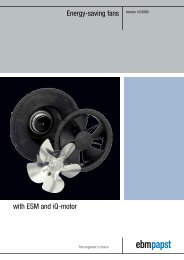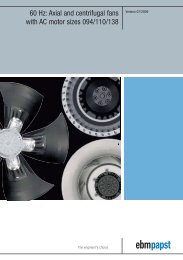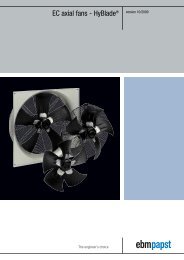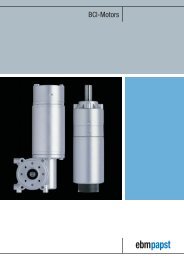Download [PDF] 2.1 MB - ebm-papst UK
Download [PDF] 2.1 MB - ebm-papst UK
Download [PDF] 2.1 MB - ebm-papst UK
You also want an ePaper? Increase the reach of your titles
YUMPU automatically turns print PDFs into web optimized ePapers that Google loves.
AXIAL FANS<br />
Figure 1: Operating range of three<br />
axial fans with identical external<br />
dimensions<br />
overall sound power with same air performance<br />
static pressure<br />
LEGEND<br />
optimum operating range<br />
fan 1<br />
optimum operating range<br />
fan 2<br />
optimum operating range<br />
fan 3<br />
static pressure<br />
optimum<br />
operating range<br />
overall sound power level<br />
air flow<br />
air flow<br />
ponent and reduced noise components in the<br />
higher frequency spectrum. With axial fans, the<br />
blade passing frequency in particular is considered<br />
to be a nuisance. This frequency is calculated<br />
from the number of rotor blades and the<br />
speed. As both fans have five rotor blades, fan 2<br />
has a slightly lower blade passing noise than<br />
fan 1. By re-designing the entire fan (rotor blades,<br />
guide vanes, air routing in the housing), it was<br />
possible to reduce both the blade passing noise<br />
and higher-frequency noise components. The<br />
higher-frequency components of the noise spectrum<br />
can be reduced by making certain changes<br />
to the rotor blade. This includes the use of winglets<br />
at the blade tips to influence the blade tip<br />
vortex and trailing edges on the suction side of<br />
the blades to alter the turbulent flow along the<br />
blades (Figure 3).<br />
Aerodynamic efficiency Winglets affect the<br />
behaviour of the blade tip vortex formed by the<br />
rotation and difference in pressure on the blade<br />
suction and pressure sides. An increase in the<br />
aerodynamic efficiency of the individual blades<br />
resulting from an improved flow permits a reduction<br />
in speed and thus has a positive influence on<br />
the noise level. Altering the dynamics of the blade<br />
tip vortex will also change its noise characteristics.<br />
The design of the trailing edge on the suction<br />
side of the fan blade alters the position at which<br />
the flow breaks down, with a noticeable effect on<br />
both efficiency and acoustics. The design of the<br />
winglets, trailing edges and all other flow components<br />
is part of the overall aerodynamic concept.<br />
Although this method yields ideal results,<br />
it involves having to find an optimum solution for<br />
each particular type of fan. Computer-based optimisation<br />
algorithms provide assistance for this<br />
process. Each point in the diagram corresponds<br />
to a fan geometry. The values were determined<br />
for the design point in each case. A Pareto front<br />
forms, along which the optimum sound pressure<br />
and aerodynamic efficiency points are distributed.<br />
The sound power level of axial fans increases<br />
with increasing aerodynamic load (expressed<br />
by the aerodynamic efficiency). Whether or not<br />
this can be generalised will have to be clarified<br />
in the course of further investigations, as all the<br />
geometries generated have different performance<br />
curves with only the design point being<br />
the same. The next step involves constructing<br />
prototype samples, taking acoustic and aerodynamic<br />
measurements and comparing the results<br />
to those forecast. The acoustic calculations<br />
were performed using a new Lattice Boltzmann<br />
method [4] in which the frequency range was restricted<br />
to 5 kHz in this case to save time. There is<br />
a very high level of coincidence between the simulation<br />
and experimental results. The shape of the<br />
frequency curve is very accurate and the individual<br />
amplitudes differ by only a few decibels. Deviations<br />
only occur in the lower frequency range.<br />
These can be attributed to the imbalance of the<br />
manually balanced test sample.<br />
As illustrated by figure 3, the sound power<br />
of a fan depends on the operating point, in other<br />
words the back pressure and the air volume demanded<br />
by the application. The acoustics of the<br />
system as a whole are also influenced by the local<br />
10<br />
techmag 02°2013


![Download [PDF] 2.1 MB - ebm-papst UK](https://img.yumpu.com/36174834/10/500x640/download-pdf-21-mb-ebm-papst-uk.jpg)


![Compact fans for AC and DC [PDF] - ebm-papst](https://img.yumpu.com/48610592/1/184x260/compact-fans-for-ac-and-dc-pdf-ebm-papst.jpg?quality=85)
![Download [PDF] 9.8 MB - ebm-papst Automotive & Drives](https://img.yumpu.com/47171334/1/184x260/download-pdf-98-mb-ebm-papst-automotive-drives.jpg?quality=85)

![Download [PDF] 3.1 MB - ebm-papst UK](https://img.yumpu.com/40847594/1/185x260/download-pdf-31-mb-ebm-papst-uk.jpg?quality=85)

![Download [PDF] 2.3 MB - ebm-papst UK](https://img.yumpu.com/35271378/1/190x252/download-pdf-23-mb-ebm-papst-uk.jpg?quality=85)
![Download [PDF] - ebm-papst UK](https://img.yumpu.com/35139755/1/190x135/download-pdf-ebm-papst-uk.jpg?quality=85)

![Download [PDF] 1.5 MB - ebm-papst UK](https://img.yumpu.com/30021941/1/184x260/download-pdf-15-mb-ebm-papst-uk.jpg?quality=85)
![DC fans - specials [PDF] 1.2 MB](https://img.yumpu.com/28121898/1/184x260/dc-fans-specials-pdf-12-mb.jpg?quality=85)
